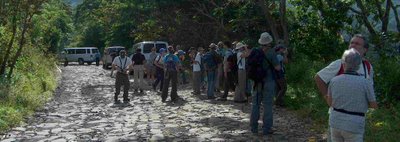The following news release comes from the
University of Georgia provides interesting information on how various North American species respond to HPAI H5N1.
Athens, Ga. – University of Georgia researchers have found that the common wood duck and laughing gull are very susceptible to highly pathogenic H5N1 avian influenza viruses and have the potential to transmit them.
Their finding, published in the November issue of the journal Emerging Infectious Diseases, demonstrates that different species of North American birds would respond very differently if infected with these viruses. David Stallknecht, associate professor in the department of population health at the UGA College of Veterinary Medicine and co-author of the study, said knowing which species are likely to be affected by highly pathogenic H5N1 viruses is a vital component of efforts to quickly detect the disease should it arrive in North America.
“If you’re looking for highly pathogenic H5N1 in wild birds, it would really pay to investigate any wood duck deaths because they seem to be highly susceptible, as are laughing gulls,” said Stallknecht, a member of the UGA Biomedical and Health Sciences Institute. “It was also very interesting that in some species that you normally think of as influenza reservoirs – the mallard, for instance – the duration and extent of viral shedding is relatively low. This may be good news since it suggests that highly pathogenic H5N1 may have a difficult time surviving in North American wild birds even if it did arrive here.”
Working under controlled conditions in an airtight biosecurity lab at the USDA Agricultural Research Service’s Southeast Poultry Research Laboratory, the researchers determined how much of the virus was shed in the feces and through the respiratory system of several species of wild birds. The work was jointly funded by the United States Poultry and Egg Association, the Morris Animal Foundation and the USDA.
“We chose birds that, because of their behavior or habitat utilization, are most likely to transmit the virus or bring the virus here to North America,” said lead author and doctoral student Dr. Justin Brown.
The species studied were: Mallards, which are often infected with commonly circulating, low-pathogenic avian influenza viruses in North America and Eurasia; Northern pintails and blue-winged teal, which migrate long distances between continents; redheads, a diving species; and wood ducks, which breed in Northern and Southern areas of the United States. The laughing gull is a common coastal species ranging from the Southern Atlantic to the Gulf Coast.
Stallknecht explained that in low-pathogenic avian influenza, most of the virus is shed in the feces of birds. The virus then spreads as other birds drink from contaminated water. The study found that in highly pathogenic H5N1 avian influenza, however, the birds shed most of the virus through their respiratory tract.
Stallknecht said that with this knowledge, scientists can detect the virus in live birds more effectively by swabbing the birds’ mouths and throats.
“Doing avian influenza surveillance is pretty tricky because there are a lot of species differences and there are also seasonal differences,” he said. “So you’ve got to pick the right species at the right time and you’ve got to collect the right samples.”
In a related study scheduled to be published in the December issue of the journal Avian Diseases, the researchers have quantified how long the virus persists in water samples. They found that highly pathogenic H5N1 avian influenza viruses don’t persist as long as common low-pathogenicity strains. In some cases, persistence times were reduced by more than 70%. This could affect transmission and supports the idea that these viruses may not have much of a chance of becoming established in North America.
Stallknecht said the finding is encouraging, but cautions that it’s difficult to put it into context without results from a study his team is currently working on that will assess the minimum amount of virus it takes to infect a bird.
This month, the researchers also received the first $875,000 of a planned three-year grant totaling $2.6 million from the Centers for Disease Control and Prevention. The grant will be used for an ambitious project that will take a broad look at the possibility of human contact with avian influenza viruses.
In the first phase of the project, the researchers will examine the prevalence, persistence and distribution of the viruses in various environments. In the next phase, they’ll work with state public health departments to determine the groups of people who – by virtue of their occupation or recreational activities – are likely to come into contact with the viruses. The researchers then will assess the ability of low-pathogenic avian influenza viruses to infect mammals so that the risk of human contact can be put into perspective.
“With this information, public health officials will be able to better understand the human health risks associated with both low-pathogenic and highly pathogenic avian influenza viruses in both domestic and wild bird populations,” Stallknecht said. “Many of these potential risks are not very well understood or even defined, and it is possible that they could be very effectively controlled with simple preventive measures.”
 Check out my latest book reviews in the brand spanking newly designed and even cooler Birder's World magazine. Pretty sweet cover of a Northern Hawk Owl, eh?
Check out my latest book reviews in the brand spanking newly designed and even cooler Birder's World magazine. Pretty sweet cover of a Northern Hawk Owl, eh? 












